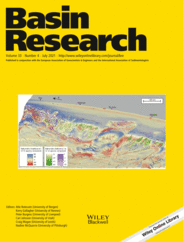
Full text loading...
 , J. P. Lovecchio2, V. Abreu3, M. Miguez4, S. Paulin5
, J. P. Lovecchio2, V. Abreu3, M. Miguez4, S. Paulin5
In this paper, we propose a high‐resolution (HR) sedimentary budget quantification at basin‐scale for the Cenozoic deposits of the Pelotas Basin (South Atlantic). A new workflow is implemented including five main steps: (1) basin‐scale analysis and characterization, (2) quality control and selection of reference 2D dip‐sections, (3) HR seismic stratigraphy analysis, (4) sediment supply estimation taking into account lithology and porosity corrections and then (5) the estimation of the sedimentary budget curve including 41 time‐intervals for the last 65 Myr. Variance ranges were determined considering the parameters of the method on the case study. The main uncertainties are related to the seismic velocities for the time‐to‐depth conversion (5%–22%), the method for lithological parameters quantification and associated porosity correction (4.4%–14.3%), the absolute ages of stratigraphic markers (1%–25%), and the proportion of in‐situ sediment production (0.3%–0.5%). For the very first time, this method allows the identification of several cycles from an entire sedimentary basin fill characterized by pulses of sediment supply (Qs) whose growth phase lasts less than 1 Myr, followed by a constant phase lasting 1–2 Myr, and finally an exponentially decreasing phase lasting 2–5 Myr. These pulses alternate with phases where the sediment supply was very low for intervals of ca. 1–5 Myr. Ten major pulses were recognized during the Cenozoic. We propose that the sediment supply dynamic in the Pelotas basin records the orogenic phases of the Andes located more than 2,000 km upstream. The recorded Qs pulses in the basin are out of phase with respect to the active tectonic phases of the Central Andes. Finally, by comparing the volume of preserved sediment and the production capacity of the catchment, we suggest that a source of sediment in addition to the Brazilian craton and the Andes should be envisaged, potentially associated with deep‐water oceanic circulation.
,Map of the Paraná catchment to Pelotas basin routing system. The Pelotas basin is highlighted with the Plio‐Quaternary isopach map.

Article metrics loading...

Full text loading...
References


Data & Media loading...

